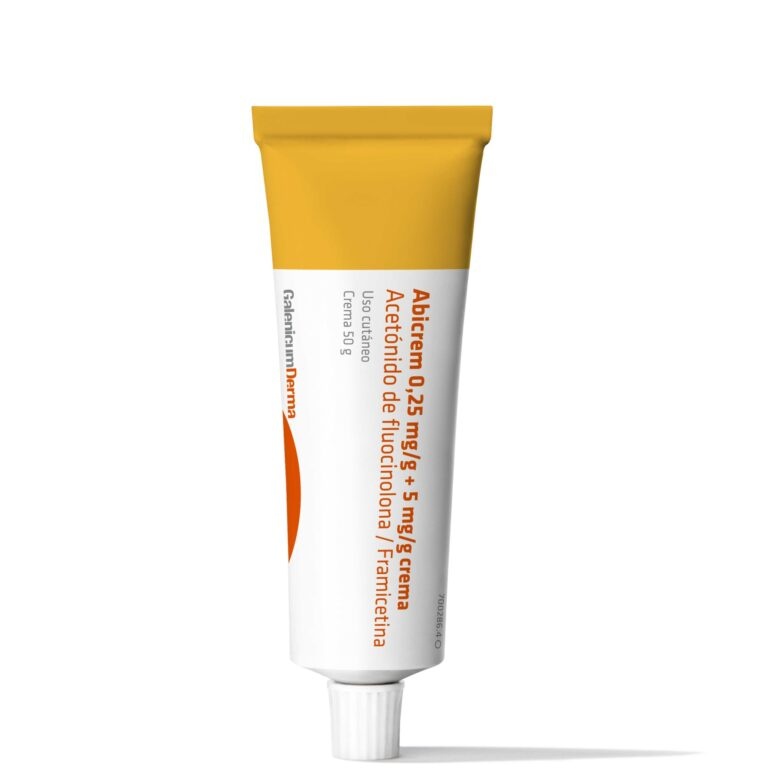

ABICREM 0.25 mg/g + 5 mg/g CREAM

Ask a doctor about a prescription for ABICREM 0.25 mg/g + 5 mg/g CREAM

How to use ABICREM 0.25 mg/g + 5 mg/g CREAM
Introduction
PACKAGE LEAFLET: INFORMATION FOR THE USER
Abicrem 0.25 mg/g + 5 mg/g cream
Fluocinolone acetonide/Framycetin
Read all of this leaflet carefully before you start using this medicine because it contains important information for you.
- Keep this leaflet, you may need to read it again.
- If you have any further questions, ask your doctor, pharmacist, or nurse.
- This medicine has been prescribed for you only. Do not pass it on to others. It may harm them, even if their signs of illness are the same as yours.
- If you get any side effects, talk to your doctor, pharmacist, or nurse. This includes any possible side effects not listed in this leaflet. See section 4.
Contents of the pack:
- What Abicrem cream is and what it is used for
- What you need to know before you use Abicrem cream
- How to use Abicrem cream
- Possible side effects
- Storing Abicrem cream
- Contents of the pack and other information
1. What Abicrem cream is and what it is used for
This medicine contains two active substances, a corticosteroid (fluocinolone acetonide) and an antibiotic (framicetin).

Antibiotics are used to treat bacterial infections and are not effective against viral infections.
It is essential that you follow the instructions regarding dosage, administration interval, and treatment duration indicated by your doctor.
Do not store or reuse this medicine. If you have any leftover antibiotic after finishing the treatment, return it to the pharmacy for proper disposal. Do not throw away medicines via wastewater or household waste.
It is used for the superficial treatment, in adults and adolescents over 12 years, of eczematous dermatitis, such as: atopic eczema, discoid eczema (circular patches), stasis eczema (eczema on the legs that appears in some patients with hypertension), contact eczema, and seborrheic eczema, if your doctor confirms or suspects that it is due to a secondary bacterial infection.
You should consult a doctor if it worsens or does not improve after 14 days.
2. What you need to know before you use Abicrem cream
Do not use Abicrem cream
- If you are allergic to the active substances or to any of the other components of this medicine (listed in section 6).
- If you currently have a skin infection caused by fungi, viruses, or if you have tuberculosis.
- If you have ulcers (wounds) on the extremities.
- In children under two years of age.
Warnings and precautions
Consult your doctor, pharmacist, or nurse before starting to use Abicrem cream.
- Corticosteroids should be used at the lowest possible dose and only for the necessary time to achieve the desired therapeutic effect. The use of this medicine should be limited to 14 days. Long-term treatment can result in skin thinning and risk of hiding infections for which this medicine is not suitable.
- If hypersensitivity (allergy) occurs, local reaction may occur, and treatment should be discontinued, the treated area washed, and drugs for itching or inflammation such as antihistamines and/or corticosteroids applied to the skin or systemically (the medicine reaches the blood) under medical supervision.
- Do not apply airtight and waterproof dressings, poorly transpirable, to large areas of skin, as this may cause the medicine to pass into the bloodstream, with a risk of toxicity.
- Do not suddenly stop treatment.
- Avoid contact with the eyes, open wounds, or mucous membranes. If accidental contact with the eyes occurs, rinse them with plenty of water and consult an ophthalmologist if necessary (see section 4).
If you experience blurred vision or other visual disturbances, contact your doctor.
Children and adolescents
- This medicine is contraindicated in children under 2 years of age and is not recommended in adolescents under 12 years of age.
- Children and adolescents during the growth period have increased absorption through the skin and are more susceptible to side effects, which may include symptoms such as obesity, growth retardation, etc. (Cushing's syndrome). Prolonged treatments, application of large amounts of medicine, and occlusion of the affected area should be avoided. Always consult your doctor.
Other medicines and Abicrem cream
Tell your doctor or pharmacist if you are using, have recently used, or might use any other medicines.
During treatment with Abicrem cream, do not use other local antibiotics or antimicrobials (substances that prevent the growth of microorganisms, such as bacteria, fungi, parasites, or viruses), due to possible chemical interaction between them.
Do not use Abicrem cream with anionic surfactant-type substances.
Pregnancy and breastfeeding
If you are pregnant or breastfeeding, think you may be pregnant, or plan to become pregnant, consult your doctor or pharmacist before using this medicine.
Pregnancy
During pregnancy, Abicrem cream should only be used if the potential benefit outweighs the potential risk to the fetus.
Breastfeeding
Do not apply this medicine to the breast during breastfeeding; do not let the child come into contact with treated areas.
Driving and using machines
Treatment with this medicine does not affect the ability to drive or use machines.
Abicrem cream contains cetyl alcohol, methyl parahydroxybenzoate (E-218), and propylene glycol (E-1520)
This medicine contains 10 mg of propylene glycol (E-1520) per gram of cream.
This medicine may cause local skin reactions (such as contact dermatitis) because it contains cetyl alcohol.
It may cause allergic reactions (possibly delayed) because it contains methyl parahydroxybenzoate (E-218).
Information for athletes
Consult your doctor before using this medicine, as it may give a positive result in doping tests. With the use of Abicrem cream, it is difficult unless large areas of skin are treated.
3. How to use Abicrem cream
Follow exactly the administration instructions of this medicine indicated by your doctor or pharmacist. If in doubt, consult your doctor or pharmacist again.
Administration: cutaneous route.
Clean the area to be treated, preferably with mild neutral detergents, letting it dry without rubbing the lesion.
The recommended dose in adults and adolescents over 12 years is one application of a thin layer of cream to the affected area, two to three times a day, gently rubbing until completely absorbed, for a maximum of 14 days.
After applying this medicine, wash your hands carefully, unless your hands are the area being treated.
Once the cream is applied, do not cover the area with airtight and waterproof materials, poorly transpirable, unless your doctor indicates otherwise.
If you use more Abicrem cream than you should
If you have applied more cream than you should, consult your doctor or pharmacist.
In case of overdose or accidental ingestion, consult your doctor or pharmacist immediately or call the Toxicology Information Service: Telephone (91) 562 04 20, indicating the medicine and the amount used/taken.
If you forget to use Abicrem cream
Do not apply a double dose to make up for forgotten doses.
Apply the dose as soon as possible and then continue with your usual treatment.
If you stop using Abicrem cream
Do not stop treatment abruptly. It is advisable to gradually reduce and discontinue it to avoid the so-called suppression or rebound syndrome due to the abrupt suspension of treatment.
If you have any further questions about the use of this product, ask your doctor or pharmacist.
4. Possible side effects
Like all medicines, Abicrem cream can cause side effects, although not everybody gets them.
Due to hypersensitivity (allergy), a local reaction may occur, which disappears when the treatment is reduced or discontinued.
The use of corticosteroids on the skin can cause the following side effects. It can occur with an unknown frequency (cannot be estimated from the available data):
Blurred vision, cataracts.
Skin infections, inflammation of the hair follicles (folliculitis), skin thinning (atrophy), dryness or cracking of the skin, itching or burning, redness (erythema), appearance of red spots, spider veins, stretch marks, acne, hair loss or increased hair growth, allergic skin reaction (contact dermatitis), inflammation of the skin around the upper lip and chin (perioral dermatitis), and changes in skin color.
Side effects can occur not only in the treated area but also affect the whole body. This occurs when administered for prolonged periods, in large areas, with dressings or occlusive materials, and/or in children (in whom absorption is increased). A condition characterized by a round face, fat accumulation, weakness...(Cushing's syndrome), increased blood pressure (hypertension), fluid retention (edema), tingling and numbness in the limbs, increased blood glucose (hyperglycemia), presence of glucose in the urine (glucosuria), low potassium levels in the blood, and stomach ulcers.
Children and adolescents.
In case of prolonged use, growth may be altered, in addition to other symptoms such as general malaise, weight loss, abdominal pain, nausea, vomiting, confusion, and muscle weakness.
Reporting of side effects.
If you experience any side effects, talk to your doctor, pharmacist, or nurse, even if they are possible side effects not listed in this leaflet. You can also report them directly through the Spanish Pharmacovigilance System for Human Use Medicines: www.notificaRAM.es By reporting side effects, you can help provide more information on the safety of this medicine.
5. Storing Abicrem cream
Keep this medicine out of the sight and reach of children.
No special storage conditions are required.
After the first opening, the cream is stable for 2 weeks. Once opened, store below 25°C. The leftover medicine should be discarded 2 weeks after opening.
Do not use Abicrem cream after the expiry date stated on the packaging after CAD. The expiry date is the last day of the month indicated.
Medicines should not be disposed of via wastewater or household waste. Place the packaging and any unused medicines in the SIGRE collection point at your usual pharmacy. Ask your pharmacist how to dispose of the packaging and any unused medicines. This will help protect the environment.
6. Contents of the pack and other information
Composition of Abicrem cream
- The active substances are fluocinolone acetonide and framicetin (as sulfate). Each gram of cream contains 0.25 mg of fluocinolone acetonide and 5 mg of framicetin (as sulfate).
- The other components are Eumulgin B-1, cetyl alcohol, Cutina MD, isopropyl myristate, propylene glycol (E-1520), liquid paraffin, methyl parahydroxybenzoate (E-218), and purified water.
Appearance of the product and pack contents
Abicrem cream is presented as a white, odorless cream, in 50g tubes.
Marketing authorization holder and manufacturer
Marketing authorization holder:
Galenicum Derma, S.L.U.
Ctra N-1, Km 36,
28750 San Agustin del Guadalix (Madrid)
Spain
Manufacturer:
Laboratorios Salvat, S.A.
C/ Gall, 30-36,
08950 – Esplugues de Llobregat. Barcelona (Spain)
Date of last revision of this leaflet:
August 2024
Detailed information on this medicine is available on the website of the Spanish Agency for Medicines and Health Products (AEMPS) http://www.aemps.gob.es/
- Country of registration
- Active substance
- Prescription requiredYes
- Manufacturer
- This information is for reference only and does not constitute medical advice. Always consult a licensed doctor before taking any medication. Oladoctor is not responsible for medical decisions based on this content.
- Alternatives to ABICREM 0.25 mg/g + 5 mg/g CREAMDosage form: CREAM, 1 mg betamethasone (as 17-valerate); 1 mg gentamicin (as sulfate)Active substance: betamethasone and antibioticsManufacturer: Organon Salud S.L.Prescription requiredDosage form: CREAM, 0.5 mg/g + 1 mg/gActive substance: betamethasone and antibioticsManufacturer: Organon Salud S.L.Prescription requiredDosage form: CREAM, 2 g fusidic acid; 0.1 g betamethasone valerateActive substance: betamethasone and antibioticsManufacturer: Laboratorios Leo Pharma S.A.Prescription required
Alternatives to ABICREM 0.25 mg/g + 5 mg/g CREAM in other countries
The best alternatives with the same active ingredient and therapeutic effect.
Alternative to ABICREM 0.25 mg/g + 5 mg/g CREAM in Poland
Alternative to ABICREM 0.25 mg/g + 5 mg/g CREAM in Ukraine
Online doctors for ABICREM 0.25 mg/g + 5 mg/g CREAM
Discuss dosage, side effects, interactions, contraindications, and prescription renewal for ABICREM 0.25 mg/g + 5 mg/g CREAM – subject to medical assessment and local rules.






